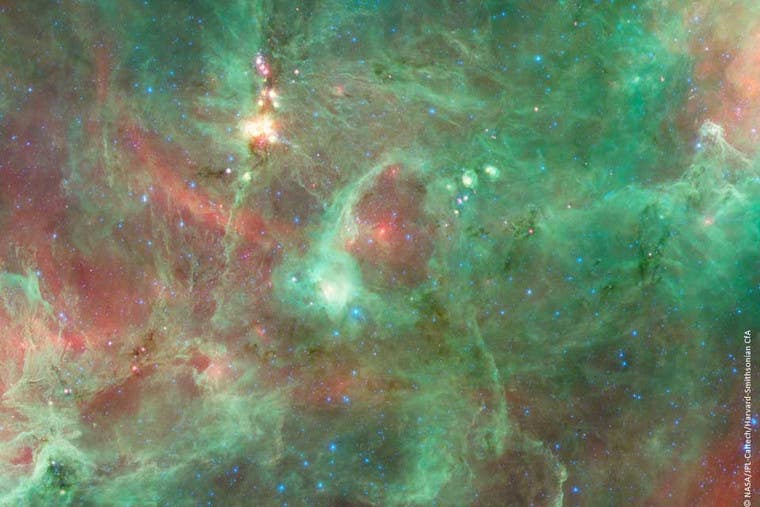French astronomers discover a glowing ‘diamond ring’ in space
A strange ring of gas in Cygnus X challenges old ideas about stellar bubbles and reveals how massive young stars change their surroundings.

 Edited By: Joshua Shavit
Edited By: Joshua Shavit

Cygnus X is about 4,500 light-years away in the constellation Cygnus, or the Swan. (CREDIT: NASA/JPL-Caltech/Harvard-Smithsonian CfA)
Far above the dusty lanes of the Milky Way, an unusual structure near the star-forming hub Cygnus X is rewriting what you think you know about how young stars shape their surroundings. Instead of the tidy, round bubbles you see in astronomy textbooks, this region features a glowing ring of gas that defies the old pattern. When viewed through the far-infrared glow of ionized carbon, it resembles a cosmic halo. Astronomers call it the Diamond Ring.
What makes it unusual is that it is not clearly expanding, like ordinary bubbles of hot gas that are being sculpted by a massive star. Those bubbles normally expand uniformly in three dimensions and can extend outward at greater than 10 km/s. The Diamond Ring only expands at about 1.3 km/s, which is a slow velocity for a structure that should be driven by a star.
Moreover, rather than expand into a spherical shape, the ring has expanded laterally, developing through a surprisingly flat cloud of gas. That unexpected structure also reveals a late-stage evolution that researchers rarely catch.
A Peculiar Ring in a Crowded Part of the Sky
The Diamond Ring is southwest of the bright ridge of DR21 in Cygnus X North. This region is nearly 5000 light-years away - close enough to the Earth for infrared telescopes like Herschel and Spitzer to resolve a labyrinth of filaments, knots, and young stars. Several of the filaments help to feed directly into the ring, which also implies a complicated and interesting history of interaction.
The ring appears bright on far-infrared images at a wavelength of 158 micrometers, which is related to ionized carbon. The carbon emission is prominent in areas where a hot gas is being energized and heated by far-ultraviolet light from young stars. The near- and mid-infrared perspective shows warm dust and small forming stars buried within the structure.
Radio observations at 4.88 GHz show that ionized gas fills the ring’s hollow center. The radio glow is brighter on the eastern side, likely because gas is thinner there and radiation leaks out more easily.
The hollow center contains the star that has formed and is driving the ring material. It was discovered during early surveys to be star 227 in the Cygnus OB2 region. When imaged with the Nordic Optical Telescope, this star was identified as a Herbig B0.5e star with a mass of 10–16 times the mass of the Sun. Radiation emitted from this star ionizes hydrogen gas in its surroundings, which in turn lights up the ring in ionized carbon gas.
Measurements of the [C II] Line
There is an enormous amount of gas in this ring structure. Measurements of the [C II] line indicate that roughly 1000 solar masses were swept up by the expanding shell. Even more surprisingly, the gas moves almost as a single unit. You do not see the fast, blue- and redshifted line-of-sight velocities expected from a normal bubble that expands both toward and away from you. Instead, the Doppler shifts vary only slightly around the ring.
To better understand that gentle motion, astronomers examined velocity-resolved maps of the structure produced by SOFIA and combined that with the molecular line data from several ground-based telescopes. The maps showed that the ring was sitting inside a sheet-like cloud.
The growth of the bubble had limited room, not pushing out and into a three-dimensional space, but with the star's radiation inflating it until the pressure burst through the top and bottom of the cloud. The hot gas escaped into lower-density regions above and below the slab, vented from the bubble, pressure dropped, and what was left inside the slab remained as a ring of compressed gas.
This idea enriches an explanation of how the structure spreads only sideways and why the three-dimensional signature of a full bubble seems not to exist. It also connects with what scientists know about molecular clouds. Many clouds are not round; they are thin and uneven and shaped by older waves of star-forming action. If the star that produced the Diamond Ring formed inside a slab like this, the bizarre shape is much simpler to visualize.
Simulations Help Confirm the Story
To test this model, researchers ran simulations using various cloud thicknesses (from 1 to 3 parsecs thick) and densities (from 167 to 500 atoms/cm3).
The best match came from a model with a cloud thickness of about 2 parsecs, with a density near 350 atoms/cm3. In this simulation, the bubble broke out the top vertically, while the ring continued to expand outward inside the cloud. Once they tilted the simulated ring by 34 degrees to match the observed view, the images looked strikingly similar to what SOFIA saw and the expansion speed of the model and internal motions lined up nicely as well.
Perhaps most surprising of all is that the model reached the observed size in only 400,000 - 500,000 years, which is much younger than the age estimates based on the spherical bubble model. “For the first time, we have observed the bubble's final stage in a distinctly flat cloud structure,” said Simon Dannhauer of the Institute for Astrophysics at the University of Cologne. The study, published in Astronomy & Astrophysics, concludes that many early age measurements of stellar bubbles could be off by a factor of five or more if assuming a spherical structure rather than a slab.
The results also highlight a small twist in the romantic notion of a cosmic diamond. The actual “diamond” at the eastern edge of the ring is a separate cluster of stars located actually hundreds of light-years in front of the ring.
A Larger Shift in How to Read Stellar Bubbles
Researchers suggest that the Diamond Ring may represent a common evolutionary state that has previously gone undetected. Once a bubble breaks out of a flat cloud, slabs internal to the cloud thicken and often become glowing "rings" rather than a full spherical shape.
Many clouds in the Milky Way appear sheetlike or filamentary, so this sort of evolution can happen more often than you expect. Dr. Nicola Schneider, a co-author of the study, said the observed work shows how a single massive star can alter a cloud. Dr. Robert Simon added that this sort of process is critical for understanding how new stars form in our galaxy.
Practical Implications of the Research
The work suggests that many cosmic bubbles may flatten into rings once they break out of thin clouds. This shift in how you read their shapes can change how you estimate their ages and how you track star formation across the galaxy.
Better age estimates can help scientists build clearer timelines for how stellar nurseries evolve. Understanding how massive stars sweep up, heat, and compress surrounding gas also helps researchers study where new stars may form in the future.
These insights can improve models of galaxy evolution and guide future observations of young star clusters.
Research findings are available online in the journal Astronomy and Astrophysics.
Related Stories
- Citizen scientists help spot massive ring-shaped radio galaxies
- Euclid space telescope discovers Einstein Ring in a nearby galaxy
- Cosmic discovery reveals how mysterious buckyballs form in deep space
Like these kind of feel good stories? Get The Brighter Side of News' newsletter.
Joseph Shavit
Science News Writer, Editor-At-Large and Publisher
Joseph Shavit, based in Los Angeles, is a seasoned science journalist, editor and co-founder of The Brighter Side of News, where he transforms complex discoveries into clear, engaging stories for general readers. With experience at major media groups like Times Mirror and Tribune, he writes with both authority and curiosity. His work spans astronomy, physics, quantum mechanics, climate change, artificial intelligence, health, and medicine. Known for linking breakthroughs to real-world markets, he highlights how research transitions into products and industries that shape daily life.



